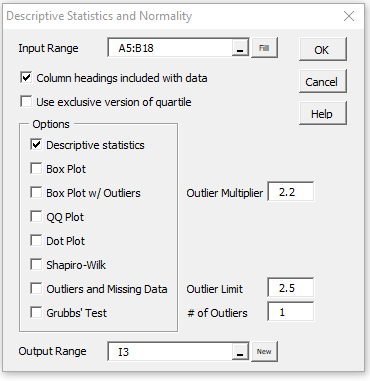
Real Statistics Function: The following two versions of the DURBIN function are available in the Real Statistics Resource Pack.ĭURBIN(R1) = the Durbin-Watson statistic d where R1 is a column vector containing residualsĭURBIN(R1, R2) = the Durbin-Watson statistic d where R1 is a m × n range containing X data and R2 is an m × 1 column vector containing Y data.ĭLowerCRIT( n, k, α, h) = lower critical value of the Durbin-Watson statistic for samples of size n (6 to 2,000) based on k independent variables (1 to 20) for α =. 75798 = d L, we reject the null hypothesis, and conclude that there is a significant positive autocorrelation. From the Durbin-Watson Table, we see that d L =. To do this, simply test 4– d for positive autocorrelation as described above.įor Example 1, with α =. If d L 2 then we should test for negative autocorrelation instead of positive autocorrelation. If d > d U do not reject H 0 : ρ ≤ 0 (presumably ρ = 0) Since most regression problems involving time-series data show a positive autocorrelation, we usually test the null hypothesis H 0: the autocorrelation ρ ≤ 0 (which we believe is ρ = 0) versus the alternative hypothesis H 1: ρ > 0, using the following criteria: 05) and each value of the sample size n (from 6 to 2000) and each value of the number of independent variables k (from 1 to 20), the table contains a lower and upper critical value ( d L and d U). The Durbin-Watson statistic can also be tested for significance using the Durbin-Watson Table. The d statistic (cell J3) is 0.725951, but what does this tell us about the autocorrelation? Hypothesis Testing on average a data element is far from the subsequent data element.Įxample 1: Find the Durbin-Watson statistic for the data in Figure 1. A value of d substantially above 2 means that the data is negatively autocorrelated, i.e. on average, a data element is close to the subsequent data element. A value substantially below 2 (and especially a value less than 1) means that the data is positively autocorrelated, i.e. A value of d = 2 means there is no autocorrelation. Where the e i = y i – ŷ i are the residuals, n = the number elements in the sample and k = the number of independent variables.ĭ takes on values between 0 and 4. The Durbin-Watson test uses the following statistic:
Using phstat in excel series#
This is especially relevant with time series data where the data are sequenced by time. where there is a (linear) correlation between the error term for one observation and the next.

Using phstat in excel serial#
On this webpage, we present a simple test to determine whether there is autocorrelation (aka serial correlation), i.e. To select multiple (nonadjacent) rows or columns, press Ctrl while you click the row or column borders that you want.A key assumption in regression is that the error terms are independent of each other. To select multiple adjacent rows or columns, click a row or column border and drag to highlight additional rows or columns. You can select entire rows and columns in much the same manner as you select ranges −Ĭlick the row or column border to select a single row or column. When you need to select an entire row or column. Excel selects the cell or range that you specified. Type the cell or range address into the Name box and press Enter. Press F8 again to return the navigation keys to normal movement. Press F8 and then move the cell pointer with the navigation keys to highlight the range. Press the Shift key while you use the navigation keys to select a range. If you drag to the end of the screen, the worksheet will scroll. Press the left mouse button and drag, highlighting the range. You designate a range address by specifying its upper-left cell address and its lower-right cell address, separated by a colon.Ĭ24 − A range that consists of a single cell.Ī1:B1 − Two cells that occupy one row and two columns.Ī1:D4 − 16 cells (four rows by four columns).

For example, cell B1 is the cell in the second column and the first row.Ī group of cells is called a range. A cell is identified by its address, which consists of its column letter and row number.

A cell is a single element in a worksheet that can hold a value, some text, or a formula.


 0 kommentar(er)
0 kommentar(er)
